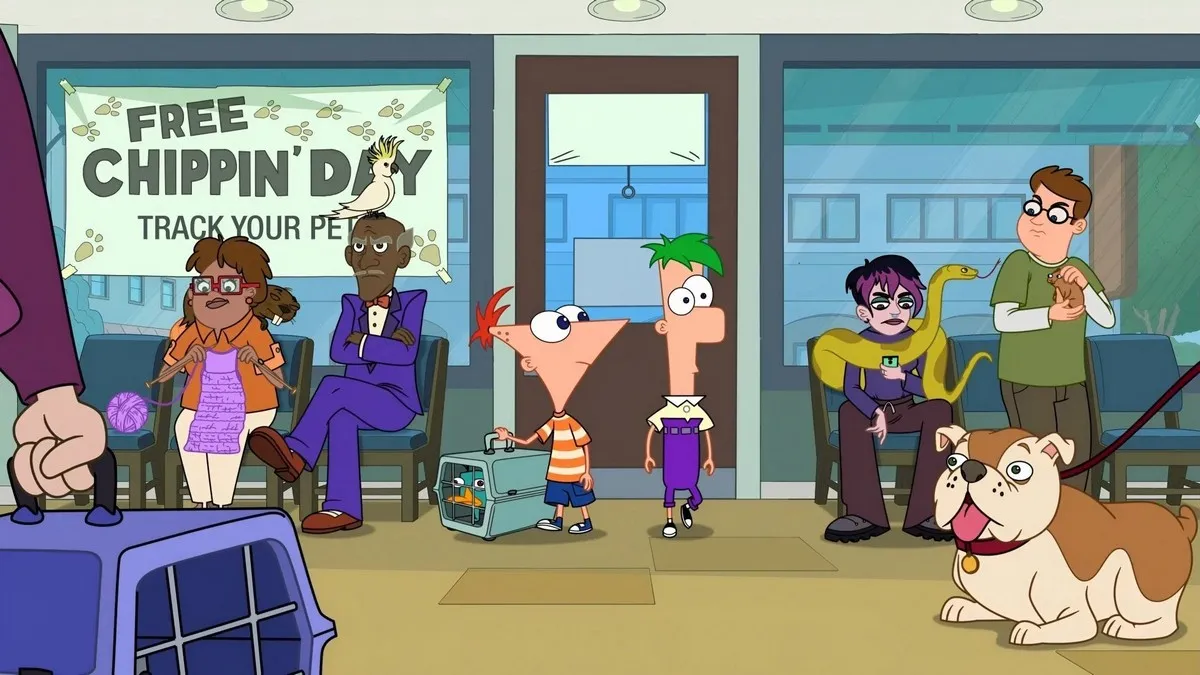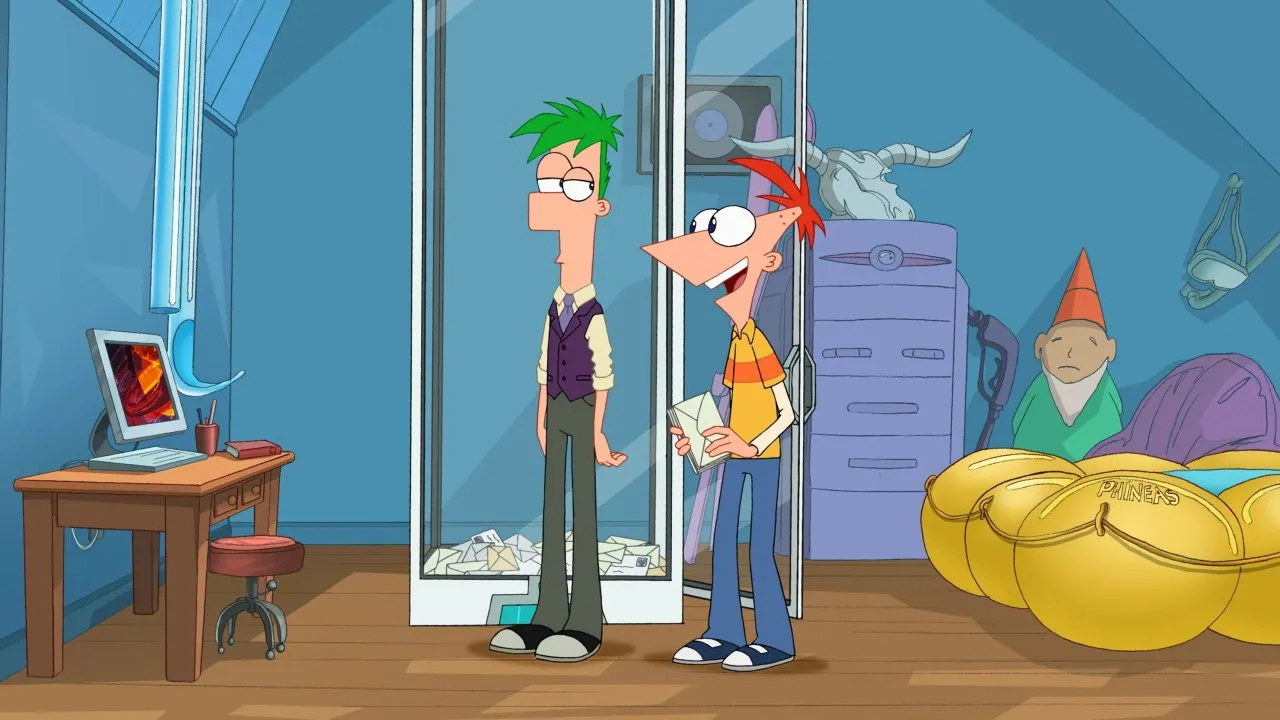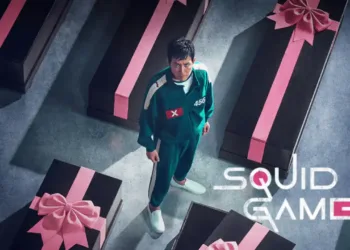A decade has passed in our world, a period of significant, often chaotic, transformation. Yet, in the fictional Tri-State Area, time proves more elastic. For the inhabitants of Phineas and Ferb, a mere school year has elapsed before we are once again poised at the start of another 104-day summer vacation.
The series returns to its foundational thesis: that summer represents not a void to be endured, but a canvas for unchecked, Promethean creation. The titular stepbrothers, Phineas and Ferb, resume their daily assault on the mundane, erecting magnificent, physics-defying structures for the sheer joy of it.
Running parallel to their creative endeavors are the show’s crucial counter-narratives. There is their older sister, Candace, forever engaged in a Sisyphean quest to impose adult-world order upon their marvels, seeking the validation of an ever-oblivious matriarch.
Beneath that is the espionage subplot of their pet, Perry the Platypus, who wages a secret war against the hilariously tragic Dr. Doofenshmirtz, a man whose grand schemes of suburban tyranny are foiled with ritualistic precision. The entire complex, interwoven machine starts up again, its impossibly optimistic spirit wholly intact.
Escaping the Revivalist’s Curse
In our current media ecosystem, the act of resurrection is fraught with peril. Most revived properties fall into one of two traps: they either become a mummified tribute to the original, afraid to deviate from a sacred text, or they are aggressively modernized, contorting themselves to address contemporary anxieties with all the grace of a dad using slang.
Phineas and Ferb manages a rather astonishing third path. Watching these new episodes is a bizarre exercise in temporal displacement; the animation, the comedic timing, the very cadence of the voice performances—all feel so hermetically sealed from the intervening decade that one might suspect the creators simply had these episodes sitting in a vault.
This is not lazy repetition. It is an act of profound confidence. The show operates with the conviction that its core engine was so well-built that it requires no modern accessories. There is no desperate lunge for relevancy, no awkward subplot about social media influencers or gig-economy anxieties. The humor remains timeless precisely because it is untethered from a specific moment. It is a work of “confident stasis,” a rejection of the idea that cultural products must constantly evolve to survive.
And yet, that stasis is an illusion. The creators introduce subtle, almost tectonic shifts that betray an awareness of the passage of time. The most significant break is the admission that a year has passed, shattering the original series’ perfect temporal loop of a single, unending summer.
This acknowledgment, however small, introduces consequence and a whisper of linear progression into a cyclical world. This newfound continuity is weaponized through meta-humor. The characters, particularly in the two-part premiere, playfully acknowledge the sheer volume of their past adventures and the audience’s familiarity with their formula. It is the show developing a consciousness, winking at its own machinery without ever breaking it.
The Necessary Regressions of a Clockwork Universe
The characters of Phineas and Ferb are less representations of people and more like archetypal cogs in a perfectly calibrated narrative machine. At the center are the boys themselves, an indivisible unit of pure creation. Phineas remains the effervescent voice of boundless optimism, the generator of ideas, while Ferb is his near-silent counterpart, the stoic agent of execution.
They do not develop; they simply are—a constant, unchangeable force against summer boredom. Their friends, too, snap back into their familiar orbits. Isabella, Baljeet, and Buford resume their roles as the essential supporting chorus, with Isabella’s character seeming to undergo a slight recalibration, leaning back into her foundational crush on Phineas. This isn’t a narrative flaw but a reset, restoring a dynamic whose potential energy is more useful to the formula than any resolution would be.
Then there is Candace, the tragic figure of the ensemble. Her mission to expose her brothers’ activities is the great Sisyphean task of children’s television. She is the avatar of order, a frantic believer in rules and parental oversight, trapped in a universe that celebrates joyful anarchy.
Her endless, preordained failure provides the show’s most consistent source of comedic tension. While her fundamental drive is unchanged, one can almost detect a subtle new texture to her frustration—a weariness born from a decade of accumulated defeat, making her rants feel less like teenage outbursts and more like existential cries into the void.
She is the embodiment of futile certainty. But the most significant—and potentially controversial—character choice lies with Dr. Doofenshmirtz. The revival performs a bold, almost brutal, act of narrative housekeeping by erasing his hard-won redemption arc.
For those who followed the show to its original conclusion, this unceremonious return to evil feels like a jarring betrayal of character development. It is, however, a philosophically necessary regression. A redeemed, content Dr. Doofenshmirtz is a closed loop, a character at the end of his story.
An evil Dr. Doofenshmirtz, on the other hand, is a perpetual motion machine of comedic pathos and bungled ambition. The show sacrifices the satisfying growth of one part to preserve the functional integrity of the whole. For this clockwork universe to continue ticking, its most entertaining villain cannot be allowed to find peace.
The Anatomy of Joyful Noise
The enduring appeal of Phineas and Ferb is not accidental; it is the result of a meticulously engineered aesthetic, a sensory language designed to transmit pure, intelligent optimism. This language is composed of three primary elements, each working in perfect concert. First is the music, which functions as a kind of liturgical requirement for each episode.
The mandatory original song is a narrative punctuation mark, a burst of expository energy that is, in this new season, reliably catchy and tonally perfect. While the series may not have yet produced another transcendent earworm on the level of its past masterpieces, the new offerings are competently infectious.
More important is the return of the iconic musical cues—the jaunty construction montage theme, Perry the Platypus’s secret agent sting—which act as Pavlovian triggers, instantly re-immersing the veteran viewer in the show’s distinct rhythm.
Then there is the humor, a multi-laminar construct designed to resonate on different frequencies simultaneously. For the child, there are bright colors and slapstick. For the adult, there is a relentless barrage of witty wordplay, cultural references, and absurd non-sequiturs delivered with a deadpan sobriety that amplifies the comedy.
The revival’s most crucial comedic tool is its heightened self-awareness. The characters’ casual references to the formulaic nature of their lives serve as a form of structural irony, a wink to the audience that says, “Yes, we know this is absurd, and that is precisely the point.” It is a remarkably effective defense against cynicism.
Finally, there is the visual style. In an age of increasingly homogenized character design, the show’s rigid, geometric aesthetic—a world built from triangles, rectangles, and circles—feels like a deliberate statement. This is a form of cartoon brutalism, prioritizing iconic clarity over expressive fluidity. The look is functional, clean, and utterly unique. By refusing to alter this visual DNA, the revival ensures its timeless quality; it does not look like a product of 2008 or 2025. It simply looks like itself.
A Treatise on Narrative Ritual
To dismiss the structure of Phineas and Ferb as merely formulaic is to miss the point entirely. It is not a formula; it is a ritual, a narrative sonnet with rules as rigid and as liberating as any classical art form. Each episode is built upon a tripartite engine.
There is the A-plot of pure, unadulterated creation (the boys’ invention), the B-plot of comically inept antagonism (Perry versus Doofenshmirtz), and the C-plot of futile authoritarianism (Candace’s quest to bust them). These three distinct narrative threads are not parallel; they are designed to collide in a predestined, causality-defying climax where Doofenshmirtz’s machinations inadvertently erase the boys’ creation, thus preserving the sacred status quo. The genius of this model is that its predictability is a feature, not a bug.
By adhering to this rigid scaffolding, the writers are freed from the burden of inventing plot mechanics. All their creative energy can be channeled into the details within the structure: the nature of the invention, the absurdity of the “-inator” of the day, the lyrics of the new song.
This is why it never feels stale. The new season demonstrates this mastery by first subverting the ritual in its two-part premiere—a higher-stakes affair that serves as a grand re-entry—before settling back into the familiar, comforting cadence.
It is an act that proves their adherence to the formula is a choice, not a constraint. This entire construct is delivered at a breathless, almost frantic pace. The sheer density of jokes, action, and musical cues demands the viewer’s full attention, creating a highly re-watchable artifact where new details are discovered upon each subsequent viewing.
Phineas and Ferb originally aired on Disney Channel and Disney XD from August 17, 2007, to June 12, 2015. In January 2023, Disney announced a revival of the series, ordering 40 new episodes to be split across two seasons. The fifth season premiered on Disney Channel on June 5, 2025, with episodes available for streaming on Disney+ the following day.
Full Credits
Creators / Executive Producers: Dan Povenmire, Jeff “Swampy” Marsh
Directors: Robert F. Hughes, Zac Moncrief, Jay Lender
Writers: Dan Povenmire, Jeff “Swampy” Marsh, Jon Colton Barry, Jim Bernstein, Joshua Pruett, Scott Peterson, Martin Olson, Aliki Theofilopoulos
Producers: Robert F. Hughes (Season 4), Brandi Young (Season 5), Susy Campos (Season 5)
Cast: Vincent Martella, Thomas Brodie-Sangster, David Errigo Jr., Ashley Tisdale, Dan Povenmire, Jeff “Swampy” Marsh, Alyson Stoner, Bobby Gaylor, Maulik Pancholy, Dee Bradley Baker, Caroline Rhea, Richard O’Brien, Mitchel Musso, Olivia Olson, Tyler Mann, Kelly Hu
Editors: Anne Harting, Ted Supa
Composer: Danny Jacob
The Review
Phineas and Ferb Season 5
This revival succeeds through a bold act of preservation. By treating its own formula not as a limitation but as a sacred text, the series avoids the pitfalls of modern reboots, resurrecting its intricate machinery of song, wit, and invention. The un-redemption of Dr. Doofenshmirtz is a necessary, if jarring, sacrifice to keep this clockwork universe ticking. It’s an intelligently crafted return to a familiar sanctuary of joyful chaos, proving that in an era of frantic change, sometimes the most radical act is to remain brilliantly, confidently the same.
PROS
- Remarkably consistent tone, humor, and animation that perfectly recapture the original's spirit.
- Intelligent, multi-layered comedy that works for multiple age groups.
- Creative and fresh scenarios built upon a masterful use of its own rigid formula.
- Avoids the common pitfalls of modern reboots, such as forced relevancy or sentimental pandering.
CONS
- The abrupt reversal of Dr. Doofenshmirtz's character development will be jarring for continuity-focused viewers.
- Its strict adherence to formula, while a strength, may not appeal to those seeking significant narrative evolution.
- The new original songs, while solid, have yet to produce a transcendent, series-defining hit.



















































